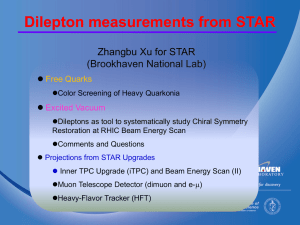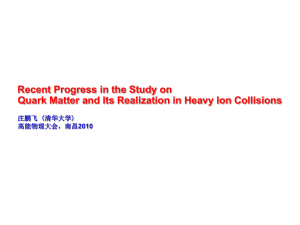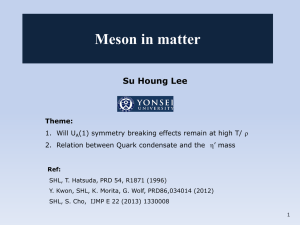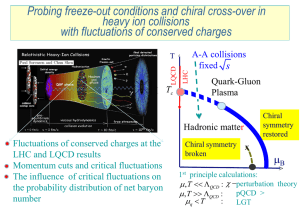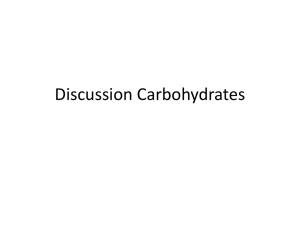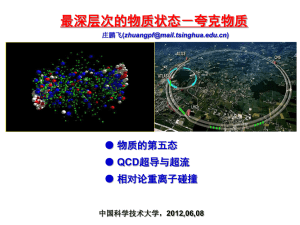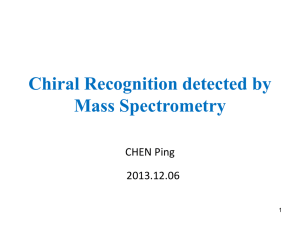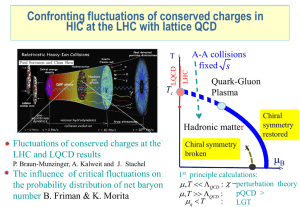Thermal Electromagnetic Radiation in Heavy
advertisement
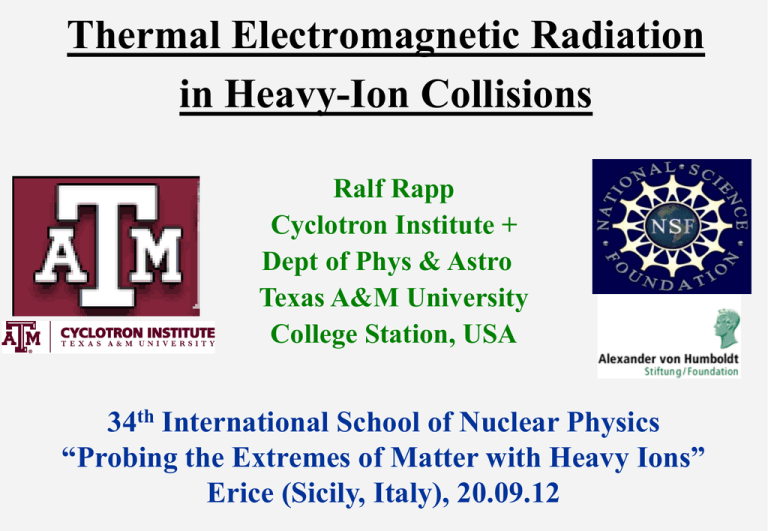
Thermal Electromagnetic Radiation in Heavy-Ion Collisions Ralf Rapp Cyclotron Institute + Dept of Phys & Astro Texas A&M University College Station, USA 34th International School of Nuclear Physics “Probing the Extremes of Matter with Heavy Ions” Erice (Sicily, Italy), 20.09.12 1.) Intro: EM Spectral Function + Fate of Resonances 2 - em 3 2 dN ee B f ( q0 ,T ) Im Πem(M,q;mB,T) 4 4 d xd q M • Electromagn. spectral function - √s < 2 GeV : non-perturbative - √s > 2 GeV : perturbative (“dual”) • Vector resonances “prototypes” - representative for bulk hadrons: neither Goldstone nor heavy flavor • Modifications of resonances ↔ phase structure: - hadron gas → Quark-Gluon Plasma - realization of transition? Im Pem(M) in Vacuum e+e- → hadrons √s = M - / qq - 0 ≈ qq 1.2 Phase Transition(s) in Lattice QCD Tpcc ~155MeV [Fodor et al ’10] • cross-over(s) ↔ smooth EM emission rates across Tpc • chiral restoration in “hadronic phase”? (low-mass dileptons!) • hadron resonance gas Outline 2.) Spectral Function + Emission Temperature In-Medium r + Dilepton Rates Dilepton Mass Spectra + Slopes Excitation Function + Elliptic Flow 3.) Chiral Symmetry Restoration Chiral Condensate Weinberg + QCD Sum Rules Euclidean Correlators 4.) Conclusions 2.1 Vector Mesons in Hadronic Matter [Chanfray et al, Herrmann et al, Asakawa et al, RR et al, Koch et al, Klingl et al, Post et al, Eletsky et al, Harada et al …] Dr (M,q;mB ,T) = [M 2 - mr2 - Sr - SrB - SrM ] -1 Selfenergies: Sr = r S S SrB,rM = r > B*,a1,K1... > r-Propagator: N,,K… Constraints: decays: B,M→ rN, r, ... ; scattering: N → rN, gA, … SPS RHIC / LHC r B /r 0 0 0.1 0.7 2.6 2.2 Dilepton Rates: Hadronic - Lattice - Perturbative dRee /dM2 ~ ∫d3q f B(q0;T) Im Pem [qq→ee] [HTL] • continuous rate through Tpc • 3-fold “degeneracy” toward ~Tpc dRee/d4q 1.4Tc (quenched) q=0 [Ding et al ’10] [RR,Wambach et al ’99] 2.3 Dilepton Rates vs. Exp.: NA60 “Spectrometer” therm fo 3 dRtherm dN mm M d q mm • Evolve rates over fireball expansion: d VFB ( ) 4 dM q0 d q 0 Acc.-corrected m+m- Excess Spectra In-In(17.3GeV) [NA60 ‘09] [van Hees+RR ’08] Mmm [GeV] • invariant-mass spectrum directly reflects thermal emission rate! 2.4 Dilepton Thermometer: Slope Parameters Invariant Rate vs. M-Spectra cont. r Transverse-Momentum Spectra Tc=160MeV Tc=190MeV • Low mass: radiation from around T ~ Tpcc ~ 150MeV • Intermediate mass: T ~ 170 MeV and above • Consistent with pT slopes incl. flow: Teff ~ T + M (bflow)2 2.5 Low-Mass e+e- Excitation Function: SPS - RHIC Pb-Au(8.8GeV) Au-Au min. bias QM12 Pb-Au(17.3GeV) • no apparent change of the emission source • consistent with “universal” medium effect around Tpc • partition hadronic/QGP depends on EoS, total yield ~ invariant 2.6 Direct Photons at RHIC Spectra Elliptic Flow ← excess radiation • Teffexcess = (220±25) MeV • QGP radiation? • radial flow? • v2g,dir comparable to pions! • under-predicted by early QGP emission [Holopainen et al ’11,…] 2.6.2 Thermal Photon Spectra + v2 thermal + prim. g [van Hees,Gale+RR ’11] • hadronic emission close to Tpc essential (continuous rate!) • flow blue-shift: Teff ~ T √(1+b)/(1-b) e.g. b=0.3: T ~ 220/1.35~ 160 MeV • small slope + large v2 suggest main emission around Tpc • confirmed with hydro evolution [He at al in prep.] Outline 2.) Spectral Function + Emission Temperature In-Medium r + Dilepton Rates Dilepton Mass Spectra + Slopes Excitation Function + Elliptic Flow 3.) Chiral Symmetry Restoration Chiral Condensate Weinberg + QCD Sum Rules Euclidean Correlators 4.) Conclusions - / qq - 0 qq 3.1 Chiral Condensate + r-Meson Broadening effective hadronic theory • Sh = mq h|qq|h > 0 contains quark core + pion cloud + Shcloud ~ + > S > = Shcore S • matches spectral medium effects: resonances + pion cloud • resonances + chiral mixing drive r-SF toward chiral restoration 3.2 Spectral Functions + Weinberg Sum Rules • Quantify chiral symmetry breaking via observable spectral functions • Vector (r) - Axialvector (a1) spectral splitting In - ds sn ( rV - r A ) [Weinberg ’67, Das et al ’67; Kapusta+Shuryak ‘93] →(2n) rV/s I - 2 1 f2r2 - FA , I -1 fπ2 , 3 I0 -2mq 0 | q q | 0 , I1 c αs 0 | (q q)2 | 0 [ALEPH ’98,OPAL ‘99] →(2n+1) rA/s pQCD pQCD • Updated “fit”: [Hohler+RR ‘12] r + a1 resonance, excited states (r’+ a1’), universal continuum (pQCD!) 3.2.2 Evaluation of Chiral Sum Rules in Vacuum • pion decay constants I - 2 1 f2r2 - FA 3 • chiral quark condensates I0 -2mq 0 | q q | 0 I -1 fπ2 I1 c αs 0 | (q q)2 | 0 • vector-axialvector splitting quantitative observable of spontaneous chiral symmetry breaking • promising starting point to analyze chiral restoration 3.3 QCD Sum Rules at Finite Temperature [Hatsuda+Lee’91, Asakawa+Ko ’93, Klingl et al ’97, Leupold et al ’98, Kämpfer et al ‘03, Ruppert et al ’05] rV/s T [GeV] Percentage Deviation • r and r’ melting compatible with chiral restoration [Hohler +RR ‘12] 3.4 Vector Correlator in Thermal Lattice QCD • Euclidean Correlation fct. P em ( ,q ;T ) dq0 rem ( q0 ,q ;T ) cosh [ q0( - 1 / 2T )] 0 Lattice (quenched) [Ding et al ‘10] 2 sinh [ q0 / 2T ] Hadronic Many-Body [RR ‘02] GV ( ,T ) GVfree( ,T ) • “Parton-Hadron Duality” of lattice and in-medium hadronic? 4.) Conclusions • Low-mass dilepton spectra in URHIC point at universal source • r-meson gradually melts into QGP continuum radiation • prevalent emission temperature around Tpc~150MeV (slopes, v2) • mechanisms underlying r-melting ( cloud + resonances) find counterparts in hadronic S-terms, which restore chiral symmetry • quantitative studies relating r-SF to chiral order parameters with QCD and Weinberg-type sum rules • Future precise characterization of EM emission source at RHIC/LHC + CBM/NICA/SIS holds rich info on QCD phase diagram (spectral shape, source collectivity + lifetime) 2.3 QCD Sum Rules: r and a1 in Vacuum • dispersion relation: 2 Im P ( s ) Π ( Q ) ds s Q2 s Q2 0 • lhs: hadronic spectral fct. [Shifman,Vainshtein+Zakharov ’79] • rhs: operator product expansion • 4-quark + gluon condensate dominant vector axialvector 4.5 QGP Barometer: Blue Shift vs. Temperature SPS RHIC • QGP-flow driven increase of Teff ~ T + M (bflow)2 at RHIC • high pt: high T wins over high-flow r’s → minimum (opposite to SPS!) • saturates at “true” early temperature T0 (no flow) 4.3.2 Revisit Ingredients Emission Rates • Hadron - QGP continuity! • conservative estimates… [Turbide et al ’04] Fireball Evolution • multi-strange hadrons at “Tc” • v2bulk fully built up at hadronization • chemical potentials for , K, … [van Hees et al ’11] 4.1.3 Mass Spectra as Thermometer Emp. scatt. ampl. + T-r approximation Hadronic many-body Chiral virial expansion Thermometer [NA60, CERN Courier Nov. 2009] • Overall slope T~150-200MeV (true T, no blue shift!) 4.1.2 Sensitivity to Spectral Function In-Medium r-Meson Width Mmm [GeV] • avg. Gr (T~150MeV) ~ 370 MeV Gr (T~Tc) ≈ 600 MeV → mr • driven by (anti-) baryons 5.1 Thermal Dileptons at LHC • charm comparable, accurate (in-medium) measurement critical • low-mass spectral shape in chiral restoration window 5.2 Chiral Restoration Window at LHC • low-mass spectral shape in chiral restoration window: ~60% of thermal low-mass yield in “chiral transition region” (T=125-180MeV) • enrich with (low-) pt cuts 4.3 Dimuon pt-Spectra and Slopes: Barometer Effective Slopes Teff • theo. slopes originally too soft • increase fireball acceleration, e.g. a┴ = 0.085/fm → 0.1/fm • insensitive to Tc=160-190MeV 3.4.2 Back to Spectral Function • suggests approach to chiral restoration + deconfinement 4.2 Low-Mass e+e- at RHIC: PHENIX vs. STAR • “large” enhancement not accounted for by theory • cannot be filled by QGP radiation… • (very) low-mass region overpredicted… (SPS?!) 4.4 Elliptic Flow of Dileptons at RHIC • maximum structure due to late r decays [He et al ‘12] [Chatterjee et al ‘07, Zhuang et al ‘09] 4.2 Low-Mass Dileptons: Chronometer In-In Nch>30 • first “explicit” measurement of interacting-fireball lifetime: FB ≈ (7±1) fm/c 3.2 Axialvector in Nucl. Matter: Dynamical a1(1260) Vacuum: In Medium: r r + S Sr + + ... S S Sr Sr a1 = resonance + ... [Cabrera,Jido, Roca+RR ’09] • in-medium + r propagators • broadening of -r scatt. Amplitude • pion decay constant in medium: 3.6 Strategies to Test For Chiral Restoration eff. theory for VC + AV spectral functs. vac. data + elem. reacts. (gA→eeX, …) constrain Lagrangian (low T, rN) constrain VC + AV : QCD SR EM data in heavy-ion coll. Realistic bulk evol. (hydro,…) global analysis of M, pt, v2 test VC - AV: chiral SRs Agreement with data? Chiral restoration? Lat-QCD Euclidean correlators Lat-QCD condensates + c ord. par. 4.1 Quantitative Bulk-Medium Evolution • initial conditions (compact, initial flow?) • EoS: lattice (QGP, Tc~170MeV) + chemically frozen hadronic phase • spectra + elliptic flow: multistrange at Tch ~ 160MeV , K, p, L, … at Tfo ~ 110MeV [He et al ’11] • v2 saturates at Tch, good light-/strange-hadron phenomenology 2.1 Chiral Symmetry + QCD Vacuum LQCD( mu ,d 0 ) : flavor + “chiral” (left/right) invariant “Higgs” Mechanism in Strong Interactions: q L • qq attraction condensate fills QCD vacuum! qR 0 | q q | 0 0 | qLqR qRqL | 0 -5 fm -3 Spontaneous Chiral Symmetry Breaking q- L q- R Profound Consequences: • effective quark mass: ↔ mass generation! m*q 0 | q q | 0 • near-massless Goldstone bosons 0,± • “chiral partners” split: DM ≈ 0.5GeV JP=0± 1± 1/2± 2.3.2 NA60 Mass Spectra: pt Dependence Mmm [GeV] • more involved at pT>1.5GeV: Drell-Yan, primordial/freezeout r , … 4.4.3 Origin of the Low-Mass Excess in PHENIX? • QGP radiation insufficient: space-time , lattice QGP rate + resum. pert. rates too small • must be of long-lived hadronic origin • Disoriented Chiral Condensate (DCC)? [Bjorken et al ’93, Rajagopal+Wilczek ’93] [Z.Huang+X.N.Wang ’96 - “baked Alaska” ↔ small T Kluger,Koch,Randrup ‘98] - rapid quench+large domains ↔ central A-A - therm + DCC → e+ e- ↔ M~0.3GeV, small pt • Lumps of self-bound pion liquid? • Challenge: consistency with hadronic data, NA60 spectra! 2.2 EM Probes at SPS • all calculated with the same e.m. spectral function! •thermal source: Ti≈210MeV, HG-dominated, r-meson melting! 5.2 Intermediate-Mass Dileptons: Thermometer • use invariant continuum radiation (M>1GeV): no blue shift, Tslope = T ! Thermometer • independent of partition HG vs QGP (dilepton rate continuous/dual) • initial temperature Ti ~ 190-220 MeV at CERN-SPS 4.7.2 Light Vector Mesons at RHIC + LHC • baryon effects important even at rB,tot= 0 : sensitive to rBtot= rB + r-B (r-N and r-N interactions identical) • w also melts, f more robust ↔ OZI 5.3 Intermediate Mass Emission: “Chiral Mixing” [Dey, Eletsky +Ioffe ’90] • low-energy pion interactions fixed by chiral symmetry = = 0 0 0 0 P Vm ( q ) (1- )P V0,m ( q ) P A0,m ( q ) P Am ( q ) (1- )P A0,m ( q ) P V0,m ( q ) • mixing parameter 3 2 d k 4 T 2 f ( wk ) 2 3 f ( 2 ) 2wk 6 f • degeneracy with perturbative spectral fct. down to M~1GeV • physical processes at M≥ 1GeV: a1 → e+e- etc. (“4 annihilation”) 3.2 Dimuon pt-Spectra and Slopes: Barometer pions: Tch=175MeV a┴ =0.085/fm • modify fireball evolution: e.g. a┴ = 0.085/fm → 0.1/fm • both large and small Tc compatible with excess dilepton slopes pions: Tch=160MeV a┴ =0.1/fm 2.3.3 Spectrometer III: Before Acceptance Correction emp. ampl. + “hard” fireball hadr. many-body + fireball chiral virial + hydro schem. broad./drop. + HSD transport • Discrimination power much reduced • can compensate spectral “deficit” by larger flow: lift pairs into acceptance 4.2 Improved Low-Mass QGP Emission 2 dRee em B f ( q0 ;T ) rV ( q0 ,q ) 4 3 2 d q 6 M • LO pQCD spectral function: rV(q0,q) = 6∕9 3M2/2 [1+QHTL(q0)] • 3-momentum augmented lattice-QCD rate (finite g rate) 4.1 Nuclear Photoproduction: r Meson in Cold Matter g + A → e+e- X e+ g r • extracted “in-med” r-width Gr ≈ 220 MeV Eg≈1.5-3 GeV e- [CLAS+GiBUU ‘08] • Microscopic Approach: product. amplitude g + in-med. r spectral fct. r Fe - Ti full calculation fix density 0.4r0 N [Riek et al ’08, ‘10] M [GeV] • r-broadening reduced at high 3-momentum; need low momentum cut! 2.3.6 Hydrodynamics vs. Fireball Expansion • very good agreement between original hydro [Dusling/Zahed] and fireball [Hees/Rapp] 2.1 Thermal Electromagnetic Emission EM Current-Current Correlation Function: m m Πem ( q ) -i d 4 x eiqx ( x0 ) [ jem ( x ), jem( 0 )]T Thermal Dilepton and Photon Production Rates: e+ e- γ Low Mass: 2 dRee - em B f ( T ) Im Πem(M,q) 4 3 2 d q M dRg - em B q0 3 f ( T ) Im Πem(q0=q) 2 d q ImPem ~ [ImDr + ImDw /10 + ImDf /5] r -meson dominated 3.5 Summary: Criteria for Chiral Restoration • Vector (r) – Axialvector (a1) degenerate In - ds s n (Im P V - Im P A ) [Weinberg ’67, Das et al ’67] I-1 fπ2 , I0 0 , I1 c αs (q q)2 • QCD sum rules: medium modifications ↔ vanishing of condensates • Agreement with thermal lattice-QCD • Approach to perturbative rate (QGP) pQCD

